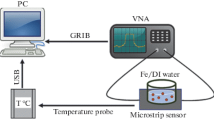Abstract
Features of monitoring solid phase formation in electrolyte solutions using sensing components in spiral slow-wave systems are considered. It is shown that insoluble compounds of nonferrous metals in solution may absorb radio frequency or microwave radiation due to resonance interaction of electromagnetic waves with dipole formations.
Similar content being viewed by others
REFERENCES
A. A. Elizarov Yu. N. Pchel’nikov (2002) Radiowave Elements of Technological Instruments and Devices Using Electrodynamic Slow-Wave Systems Radio i Svyaz’ Moscow
Yu. N. Pchel’nikov et al., Izmer. Tekh., No. 6, 57 (1964).
M. V. Astakhov, V. A. Muratov, and A. A. Frantsuzov, J. Phys. Condens. Matter., 7, 4556 (1995).
M. V. Astakhov, M. V. Kozulina, and A. A. Semenov, Proc. First Internat. Conf. On Highly-Organized Compounds, St. Petersburg, Vol. 3 (1996).
M. V. Astakhov and L. A. Reznik, Proc. Internat. Conf. Currentless Electronics, Moscow (1997).
Additional information
Translated from Izmeritel’naya Tekhnika, No. 9, pp. 60–62, September, 2004.
Rights and permissions
About this article
Cite this article
Astakhov, M.V., Evstratova, L.Y., Elizarov, A.A. et al. Application of sensing components in spiral slow-wave systems for monitoring the formation of solid phases in electrolyte solutions. Meas Tech 47, 936–939 (2004). https://doi.org/10.1007/s11018-005-0018-z
Received:
Issue Date:
DOI: https://doi.org/10.1007/s11018-005-0018-z




